New Sazae: a classic Tokyo gay bar
Anything goes at this venerable Shinjuku Ni-chome club, open since 1966
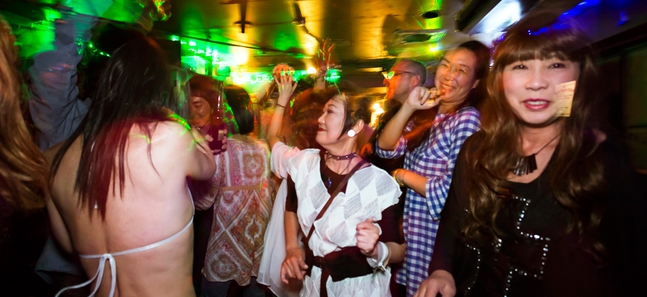
Posted: Mon May 13 2013
When you’re gay in Tokyo, Shinjuku Ni-chome is the place to party. Spread across several blocks of narrow streets packed with hundreds of bars, the capital’s gay quarter has a reputation to rival New York’s Christopher Street and San Francisco’s Castro District – albeit in more coddled surrounds. By night, it’s the prime destination for the city’s LGBT crowd, who flock to dance clubs or more discrete watering holes; by day, the bars give way to quirky restaurants and coffee shops. And like nearby Kabukicho, Ni-chome never seems to pause for breath: year-round, it’s the neighbourhood that never sleeps.
Originally an inn town on the road out of Edo, Shinjuku took on a seedier guise as the years passed; by the end of World War II, it had the dubious honour of being the foremost red-light district in Tokyo. The area was still catering to a strictly hetero crowd at that point, however. Gay bars only started to appear in the capital after the war, first arriving in the downtown districts of Ginza, Shimbashi, Ueno and Asakusa. These gradually spread into what’s now Shinjuku San-chome, but it took until the second half of the ’60s before they finally made their way into Ni-chome. And one of the first, in 1966, was a place called Sazae.
Simply labelling New Sazae a ‘gay bar’ doesn’t quite do it justice, mind you. When I first set foot there in the late ’70s, at the age of 21 or 22, it was known as a ‘gay disco’. Back then, if you climbed the staircase in the middle of the night and pushed open the door, you’d be hit with a blast of the latest dance hits, blaring out at top volume from a dimly lit room full of men shaking their stuff on the dancefloor.

New Sazae’s manager, Shion, always dresses to impress at the weekend
‘No, no, no, it’s still just like that! It’s a disco now more than ever!’ says Shion, the master of New Sazae. The current incarnation of Sazae changed its name when it moved to its present location, 12 years after the original club opened. It gained its new master with the new premises, and Shion has been fully involved ever since, running the club, dealing with customers and managing the place for over 35 years now.
Shion, who is a quarter French, was born in Nagasaki Prefecture. His early life wasn’t easy: having lost both parents when he was a child, he bounced from facility to facility until he was eventually taken to Lyon, France, where he lived with his grandfather for four years. He returned to Japan to attend junior high school, and once back on home soil, his chiseled features and exotic looks enabled him to work as a fashion model. This in turn led to a stint as a local radio host, and he was soon something of a star in Nagasaki.
After graduating high school, and with no immediate family in Japan, Shion decided to pursue further education at Tokyo’s Sophia University, in order to guarantee his future here. Once arrived in the capital, he quickly fell in with the music and theatre scenes, which in turn led him and his friends to Sazae. He became a regular customer there, but it wasn’t long before the owner and staff took a liking to him and he earned his place on the other side of the counter.
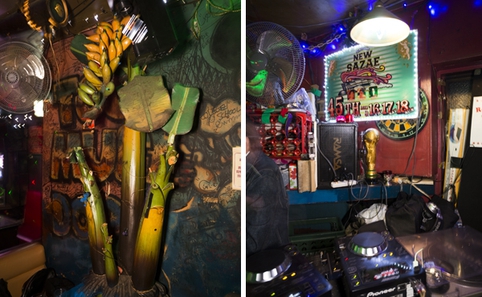
Left: a faux banana tree enlivens the box seating area. Right: the weekend soundtrack ranges from disco to Madonna to K-pop
New Sazae wasn’t the only well-known late-night disco during the ’70s: you could also wiggle your hips at joints such as Mako (now just a regular bar, upstairs from New Sazae) and Black Box. These small nightclubs drew youngsters who were looking for something more than the discos in Kabukicho had to offer, as well as media and fashion industry types, and bar girls and boys wanting to let off steam after finishing their shifts in Ginza and Roppongi.
But while the disco era would prove short-lived, New Sazae endured. These days, it’s particularly popular with ‘gaisen’ – Japanese guys who prefer to hook up with foreigners, and vice versa. According to Shion, the ratio of gay to straight clientele has also shifted in recent years. ‘To begin with, I’d say about 90 percent of the people who came here were gay,’ he says. ‘But nowadays it’s more like 20 to 30 percent.’ The number of straight, cross-dressing customers is also on the rise. ‘We welcome everybody, so we get all sorts of people coming here looking for a safe environment to let their hair down,’ says Shion. And sure enough, come the weekend, all types of partygoers arrive looking to socialise, express themselves and have fun – often dressed in truly outlandish outfits.
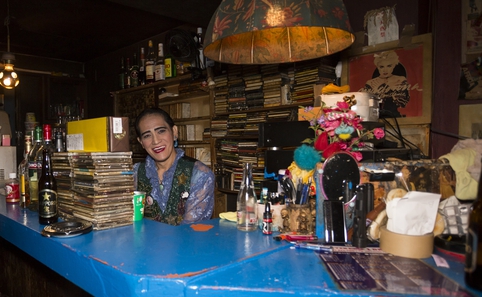
Shion keeps the drinks (and smiles) coming from behind the bar
Open until 5am on weekdays and 7am at weekends, 365 days a year, the club is a perfect fit for the neighbourhood that never sleeps, and Shion says the past 35 years have gone by ‘in the blink of an eye.’ ‘As long as we’re open, I’m able to meet old friends and customers from days gone by,’ he continues. ‘I don’t think of New Sazae as the place where I work: I prefer to think of it as somewhere that’s given me the chance to meet all kinds of people. It still is, in fact.’
It seems what was popular then is still popular now: the decor hasn’t really changed since the ’70s and, generally speaking, neither has the music. (‘We still play mainly ’70s and ’80s soul and disco,’ says Shion). Extra staff help out on weekends, but on weekdays Shion runs the place alone, pouring drinks, changing CDs and chatting to the regulars. ‘I’ve absolutely no time for getting old or sick!’ he says with a laugh – which is lucky, because if New Sazae were ever to close, Ni-chome and Tokyo would be losing something absolutely irreplaceable.

Left: Just in case you'd forgotten how old the place was, this table video game should remind you. Right: New Sazae, since 1966
Gay or straight, young or old, kinky or straitlaced: whatever your preferences, New Sazae welcomes all comers. Entry is ¥1,000 and includes one free drink, after which everything (food and drinks) is a not-unreasonable ¥700 a pop. Swing by and experience the area’s oldest, most welcoming gay bar – after all, if you’ve never been to New Sazae, you’ve never been to Ni-chome.
New Sazae: 2F, 2-18-5 Shinjuku, Shinjuku-ku (03 3354 1745)
Kyoichi Tsuzuki is the author of books including 'Roadside Japan' and 'Tokyo Style'. Official website: www.roadsiders.com
Kaoru Yamada official website: www.kaoruyamada.com
Tags:
Tweets
- About Us |
- Work for Time Out |
- Send us info |
- Advertising |
- Mobile edition |
- Terms & Conditions |
- Privacy policy |
- Contact Us
Copyright © 2014 Time Out Tokyo











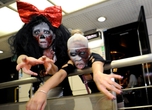


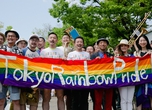

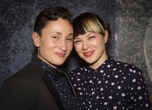
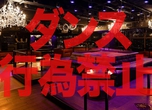
Add your comment